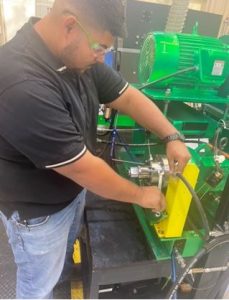We recently completed high-speed rotary seal testing at dredging and submersible pump conditions on two Kalsi Seal geometries. The two rotary seal geometries were selected because they can operate in an abrasive fluid environment, and they have a significantly lower hydrodynamic pumping related seal leak rate than other Kalsi Seals used in high-speed applications. This low leak rate reduces equipment environmental impact and simplifies equipment design.
High-speed rotary seal test setup and results
A pair of the same type of Kalsi Seal was installed in a seal carrier that axially preloads one of the rotary seals against the environment side gland wall. The axial preloading is accomplished by using a wave spring that acts on a moveable lubricant side gland wall. The other rotary seal was installed in a standard Kalsi Seal groove. This type of spring-loaded arrangement is used to improve the ability of the rotary seal to exclude abrasives in an environment fluid.
The high-speed rotary seals were run on a 2.75” (69.85mm) diameter shaft rotating at 1,290 RPM (equivalent surface speed to a 50mm shaft rotating at 1,800 RPM). An ISO 68 viscosity grade seal lubricant was pressurized to 50 psi between the seals. The temperature of the seal lubricant was maintained at 130°F by intermittently circulating coolant at 4 GPM through the shaft bore.
Rotary seal geometry 1 — A pair of Enhanced Lubrication SealsTM (PN 568-43-10) was run for 50 hours to establish the hydrodynamic pumping related seal leak rate and to observe any potential progressive seal wear. The seals were in excellent condition at the conclusion of the test. The seal leak rate was 15 mL/hour. This high-speed rotary seal test was repeated with a new set of seals to confirm performance.
Rotary seal geometry 2 — A pair of Standard Width Kalsi Seals (PN 587-12-30) was run at the same conditions as the Enhanced Lubrication Seals. The objective of this test was to confirm that the seal waves lubricate well at this high-speed condition and to collect leak rate data. The seals were in excellent condition at the conclusion of the 50 hour test. The seal leak rate was 2.1 mL/hour. This high-speed rotary seal test was repeated with a new set of seals to confirm performance.
For the longest seal life, select a seal with the highest hydrodynamic seal leak rate that can be accommodated by the application.
Contact our engineering staff for assistance with high-speed seal selection and implementation.



